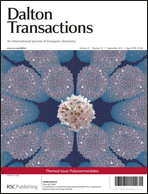We theoretically investigate a novel switching phenomenon based on the divacant Keggin-type polyoxotungstate bearing chiral organophosphonate [{NH2CH(CH3)PO}2(γ-SiW10O36)]4−, that is the synchronous chiroptical and nonlinear optical (NLO) switch triggered by redox. The ECD calculations on the Boltzmann weighted conformations of the three oxidation states of this chiral polyoxometalate (POM) clearly present a chiroptical switching process. The electronic transition and the bond-length alternation studies show that the chirality transfer from chiral carbon atom to POM cage increases as the polyanion is reduced. Simultaneously, the static first hyperpolarizability of studied chiral POM quadrupled from the oxidized state to the 1e-reduced state, and is further doubled to the 2e-reduced state, which is mainly due to the increasing electronic-dipole-allowed d–d charge transfer transitions in the POM cage. This work firstly reproduces the ECD spectrum of chiral POM with high accuracy and proves the possibility for confirming the molecular conformations of flexible chiral POMs in solution by the aid of ECD calculations. Most importantly, a sensitive diplex switch based on a chiral POM is predicted in theory, which may aid the design of novel POM-based switches.

You have access to this article
 Please wait while we load your content...
Something went wrong. Try again?
Please wait while we load your content...
Something went wrong. Try again?


 Please wait while we load your content...
Please wait while we load your content...